What is Democracy?
The definition of Democracy as per Merriam-Webster is a form of government in which the people choose leaders by voting; especially the rule of the majority. Democracy stands in opposition to dictatorships, monarchies, theocracies, aristocracies, and oligarchies, though the lines between the various forms of government are often blurred and forms are combined. Most governments claim to be democratic, but as Democracy is often considered the most challenging form of government, there are difficulties in the large-scale application of the government. The theory of a true democracy is difficult to put into practice, and many democratic governments end up being ruled by an elite class.
There are many requirements for a government to be considered a democracy, including legal equality (votes are counted equally), freedom (protected rights and liberties), and the rule of law. The two main divisions of democracy are direct democracy and representative democracy (or democratic republic). In a direct democracy, all citizens have direct participation in the government decisions, while in a representative democracy, all citizens elect representatives who act on behalf of the voters.
The Economist Intelligence Unit tracks the status of the democracy around the world, ranking them from full democracy to flawed democracy, hybrid governments, and authoritarian governments. There are a total of 25 full democracies according to this standard, which is based on several categories, including civil liberties, and free and fair elections. Following is a look at some of the democratic countries around the world.
Greece
Greece is the birthplace of democracy, with the city-states of Classical Greece, especially Athens, where the entire concept originated. The initial manifestation of democracy began with Solon, a statesman and poet of Athens around 600 BC, whose constitutional reforms paved the way for modern forms of government. About 100 years later, a radical reformer called Cleisthenes arose around 508 BC, ushering in the democratic constitution.
Democracy was created in opposition to the aristocracy, or rule of the elite, and the term “democracy” means “people power.” Despite having the first democratic government, Greece became a monarchy for a period during the 19th century, which was abolished with the 1924 referendum and replaced by the Second Hellenic Republic. This was short lived, as monarchy was briefly restored in 1935 until a coup the following year. A 1975 referendum established a new constitution, with the Fifth Revisionary Parliament of the Hellenes. The new constitution established the separation of powers into the three branches of government and a guarantee of civil liberties and social rights. Greece is governed by the prime minister as the head of government, who is the party leader chosen by parliament vote, while the president of the republic has limited powers. The unicameral (Hellenic) parliament of Greece has 300 members who are elected by the people.
Greece has a two-party system with the liberal-conservative New Democracy Party and the social-democratic Panhellenic Socialist Movement, while other parties include the Popular Orthodox Rally, Coalition of the Radical Left, Communist Party, and Popular Association of Golden Dawn.
India
The world’s largest democracy, India, has a parliamentary republic under a constitution with judicial review. There are six major national parties and over 40 regional parties, with the Indian National Congress (liberal) and the Bharatiya Janata Party (conservative) as main parties. India became a republic with its new Constitution of India on January 26, 1950, which has made it a secular democratic republic. India has a strong central government with 3 federal branches: Executive, Legislative, and Judicial. The president is the head of state and the prime minister is head of government. The president is elected by an electoral college, while the president appoints the prime minister based on the majority party of the parliament’s lower house. The states and some union territories of India are ruled by elected governments, while other union territories are governed by appointed officials.
Norway
Norway adopted its constitution in 1814, drawing inspiration the US and French Revolutions to form a new government with division of power. Officially, Norway is considered a constitutional monarchy with a parliamentary government, with the King of Norway as head of state and the prime minister as head of government. However, the monarch, King Harald V, who ascended the throne in 1991, is considered mainly a ceremonial position and symbol of the nation’s unity. The Monarch does oversee security issues and retains the ability to approve the government budget, which is reviewed by the Council of State.
Despite having a monarch, Norway is considered the highest rated democracy in the world according to the democracy index. Norway is a representative democracy with 169 representatives in Parliament, 150 of which are elected directly. The remaining representatives are selected to represent the party affiliations of the popular vote, and are known as leveling seats. Norway has a multiparty system with parties including the Labour Party, Conservative Party, Red-Green Coalition, the Socialist Left Party, and the Centre Party.
Unlike many forms of democratic government, Norway’s government is associated with the Lutheran Church, which is a controversial issue in the country and may soon change.
United States
The United States is a constitutional republic and representative democracy, as described in the US Constitution, which was ratified on June 21, 1788. The Constitution of the United States outlines the separation of powers (into the Legislative, Executive, and Judicial branches), so that control of the country is balanced. The Constitution, which was based on common law and the Magna Carta, and its 27 amendments also provide for basic civil rights, religious freedom, and the separation of church and state. Early in its history of democracy, people were not equal under the law, as slaves, freed slaves, and women were disenfranchised until amendments were made to the Constitution.
The head of government of the United States is the president, who is indirectly elected via an electoral college by the popular vote, who has a limited term, so as not to become too powerful. Congress has the ability to impeach a president should the president if necessary. The United States Congress is bicameral, with the Senate and House of Representatives made up of elected officials from the each of the states. There are 100 Senators (2 from each state) and 435 members of the House, with the number of representatives from each state determined by state population (California has the most with 53 representatives).
The US has a two-party system, with current major parties the Democratic Party (since 1824) and the Republican Party (since 1854), while major the third party is the Libertarian Party. Some critics call the US government an oligarchy.
France
France is ruled by a unitary semi-presidential republic, under Constitution of the Fifth Republic, since September 28, 1958. The French Revolution in 1789 to 1799 ended monarchy in France and ushered in democracy, as well as establishing the division between church and state. France’s Declaration of the Rights of Man and of the Citizen in 1789 set the stage for France’s democracy, and set an example that would later be followed by the United States and many other countries. The constitution of France, adopted much later, references the Declaration in its preamble, which lays out the foundation of the government, including equality under the law, presumption of innocence, freedoms of speech, religion, and opinion, and other basic rights.
France is governed by the President of the Republic (Francois Hollande currently), the head of state, and the Prime Minister (Manuel Valls currently), head of government. The president is directly elected by the public, while the prime minister is appointed by the president. French parliament is bicameral, with the National Assembly and the Senate, in which representatives are elected by the people in their district, directly in the case of the National Assembly, and by the electoral college in the case of the Senate.
The two major French parties are the French Socialist Party (left-wing) and the Union for a Popular Movement (right-wing).
Canada
Canada is governed by a parliamentary democracy, but also a constitutional monarchy as a Commonwealth Nation. Canada’s constitution is one of the world’s oldest, also based on the Magna Carta, and its early version was passed in 1867. Despite having Queen Elizabeth II as head of state, Canada is considered a full democracy by the democracy index, and has shared power among its several government authorities. The Governor General of Canada (David Lloyd Johnston) serves as the representative of the Queen in Canada, and royal governance is limited and somewhat a ceremonial role.
The head of government of Canada is the Prime Minister (Stephen Harper), who is appointed by the governor general based on the plurality in the House of Commons. The Parliament of Canada includes the House of Commons and the Senate. There are 105 senators, who are appointed by the governor general with the prime minister, based on geographic representation. The senators serve until they are 75 years old. The House of Commons has 308 members, elected by direct vote of the Canadian public. The members of the House of Commons represent each electoral district of the country.
Major parties in the Canadian parliament include the Conservative Party, New Democratic Party, the Liberal Party, Bloc Quebecois, and the Green Party.
South Africa
South Africa is a constitutional democracy, with a parliamentary republic with a president as head of state and government, and parliament. South Africa became a constitutional democracy in 1994, though the current Constitution of South Africa came into effect in 1997, with important contributions from several major figures in South African history, including Nelson Mandela, Desmond Tutu, and Albert Luthuli, who each separately earned a Nobel Peace Prize for their contributions (in 1993, 1984, and 1960, respectively). South Africa’s constitution was essential in the end of apartheid, moving towards equal representation under the law, and defines the balance of powers into the three main branches.
The Parliament of South Africa is bicameral, with the National Assembly (lower house) and the National Council of Provinces (upper). There are 400 members of the National Assembly, elected by the people in a system based on party affiliations and provincial and national representatives. The National Council of Provinces has existed since 1997 (formerly the Senate), and the representatives are indirectly elected by provincial legislature. Parliament elects the president based on the leader of the majority party, while the Cabinet is made up of ministers of the various departments. Below the president is the deputy president.
Major parties in South Africa include the African National Congress, the Democratic Alliance, the Congress of the People, and the Inkatha Freedom Party.
Costa Rica
The form of government of Costa Rica is a constitutional republic, making it the only country in Latin America to have been a democracy since 1950. Costa Rica became ruled by a democratic government in 1949, establishing the division of powers. The head of state and government of Costa Rica is the president, with two vice presidents, while the Legislative Assembly is made up of 57 elected deputies. The Legislative Assembly is selected by an election, using proportional representation in each province. Voting in Costa Rica is compulsory and a national holiday.
Costa Rica has a multiparty system with 9 current parties with legislative seats: National Liberation Party, Citizens’ Action Party, Broad Front, Social Christian Unity Party, Libertarian, Costa Rican Renovation, National Resoration, Accessibility without Exclusion, and the Christian Democratic Alliance.
Switzerland
Switzerland is considered a federal directorial republic, but it is also a direct democracy. Switzerland is governed by the Federal Council, with the President of the Confederation, elected by the Federal Assembly. The Federal Assembly is the bicameral Swiss Parliament, which includes the Council of States and the National Council. The Council of States consists of 46 representatives elected by the cantons and half-cantons of France. The National Council consists of 200 members elected by proportional representation by canton.
Switzerland has one of the world’s oldest constitutions, dating back to 1848, though it was updated in 1999, the federal structure remained the same. Under the constitution, amendments may be introduced by any citizen through a referendum with 100,000 votes within 18 months, which makes Switzerland a direct democracy. The public can also overturn parliament decisions in this manner. The government has three levels: the federal, canton, and commune.
Switzerland has a multiparty system with a few major parties, including the Christian Democratic People’s Party, the Conservative Democratic Party, Free Democratic Party, Social Democratic Party and Swiss People’s Party.
South Korea
South Korea is ruled by a constitutional democracy, as established by the Constitution of the Republic of Korea in 1948, which has been amended many times. The government is divided into three branches for the traditional democratic balance of powers. The head of government and state of South Korea is the president, elected directly by the people for 1 term of 5 years. The president is the head of the executive branch, but can be impeached when necessary. The president has a Cabinet of 15-30 advisors, including a prime minister and vice prime minister and leaders of 17 ministries. The Cabinet of South Korea differs slightly from others in that they have some aspects similar to presidential republics and some that are similar to parliamentary cabinet systems.
The unicameral legislature is a single assembly of 299 members, elected mostly by the constituencies, though 56 are elected via proportional representation. There are 4 main political parties currently represented in South Korean assembly: Saenuri Party, New Politics Alliance for Democracy, Unified Progressive Party, and the Justice Party.

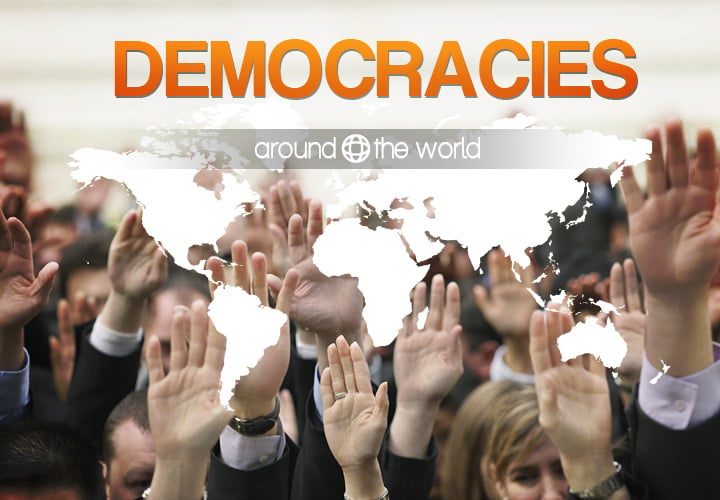

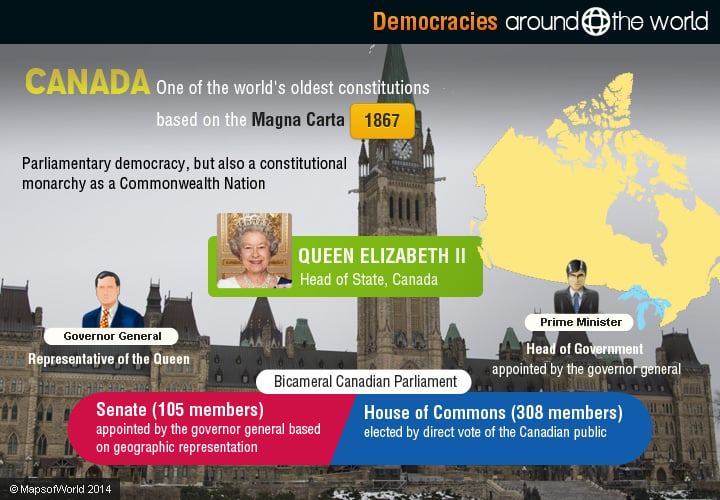
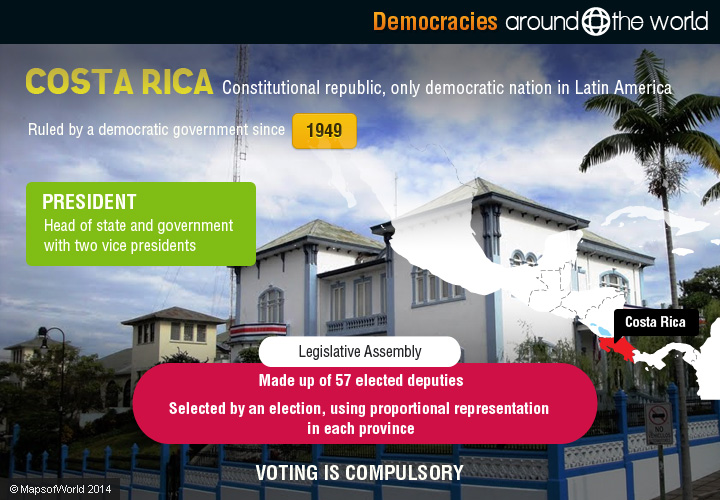
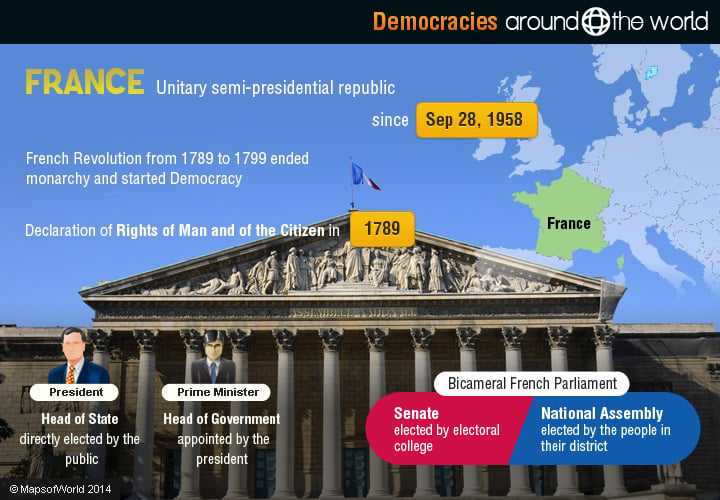
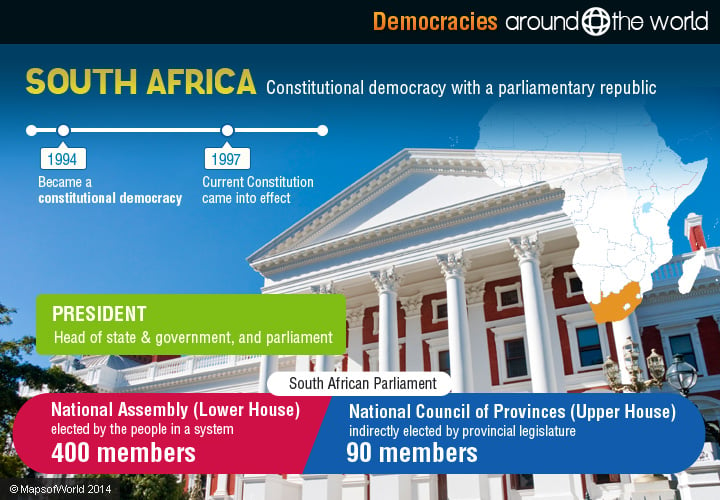
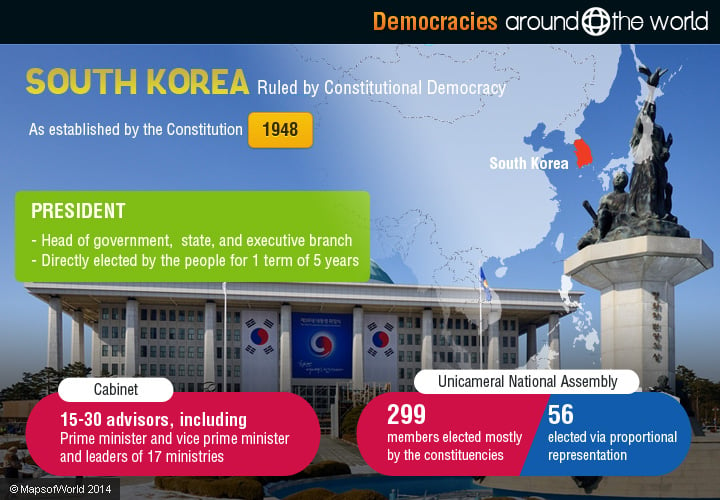
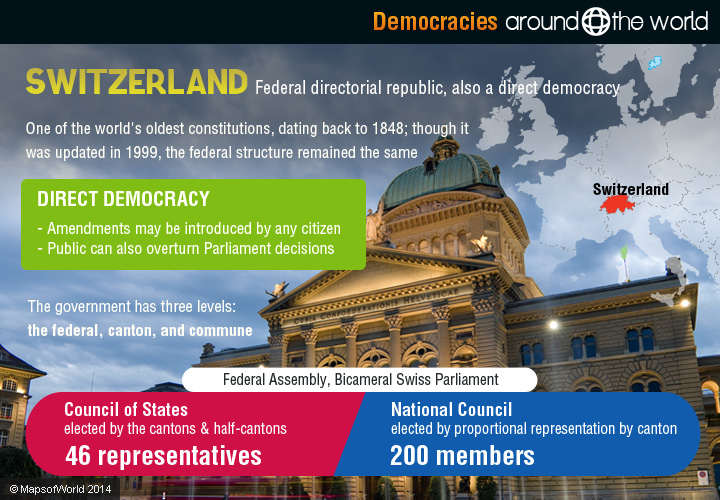

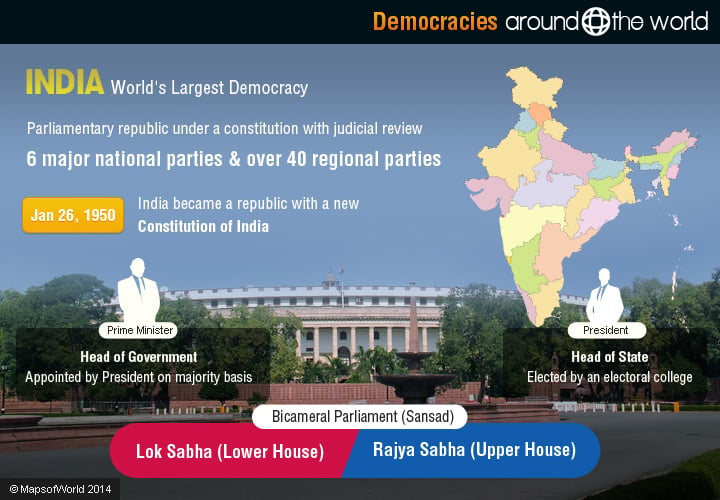
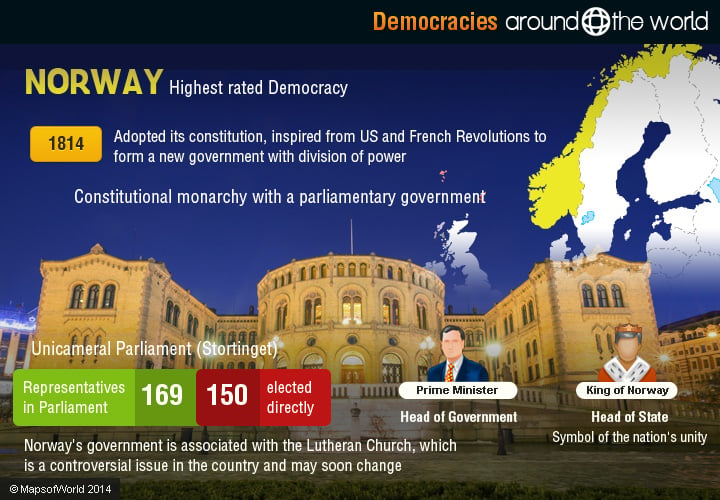

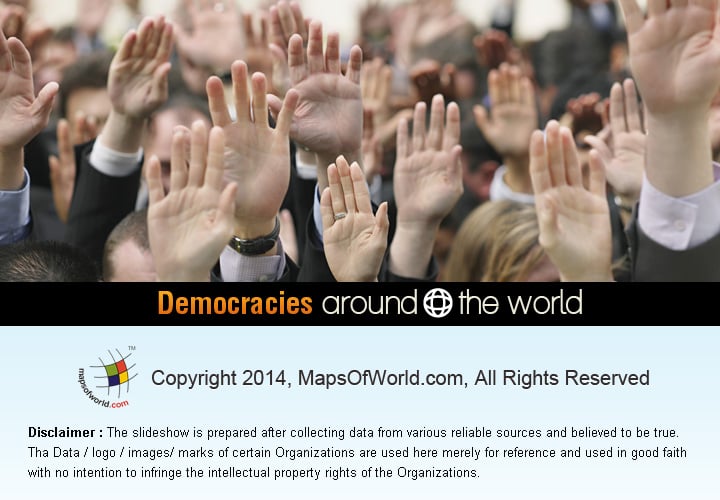
Comments are closed.